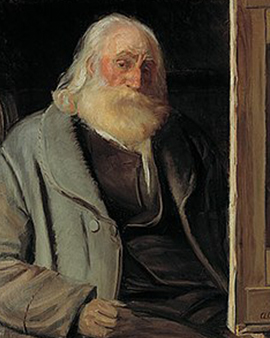With an incomparable eye for the details and subtleties of the natural world, Vilhelm Kyhn, an eminent Danish landscape painter and former professor at the Royal Danish Academy of Art, became a shining star in the golden age of Danish art. Born in Copenhagen on March 30, 1819, and dying in Frederiksberg on May 11, 1903, Kyhn left a multi-layered artistic legacy that is admired and celebrated to this day. His life, marked by artistic endeavor and pedagogical passion, is a striking example of an unquenchable thirst for knowledge and a determination to share it with others. Vilhelm Kyhn, son of Carl Gottlieb Kyhn and Sara Marie Hendriksen, began his professional career in a merchant's office, but quickly decided to pursue an artistic career. The Copenhagen Academy of Art became his home, where he pursued classicism studies under the tutelage of Christoffer Wilhelm Eckersberg and the history painter Johann Ludwig Lund. Likewise, he was inspired by Niels Lauritz Høyen and the poet and philosopher N. F. S. Grundtvig. Kyhn refined his technique until he achieved his first significant success in 1843 with his debut at the Charlottenborg Spring Exhibition in Copenhagen.
His artistic life was characterized by a constant quest for knowledge and further development. This was also evident in his many travels, which he undertook to France and Italy on the basis of an academy scholarship in 1850. Further study trips took him to Sweden, Norway, and Paris, and each visit broadened his understanding of art and expanded his repertoire. In the latter part of his life, Kyhn devoted himself to teaching and opened his own drawing and painting school, which quickly became a magnet for a group of young, disaffected artists and academy students known as the "Cave Academy." This group became the forerunner of the "Kunstnernes Frie Studieskoler" founded by Laurits Tuxen in 1882. Between 1865 and 1895, he also directed a painting school for women, the "Tegneskolen for Kvinder", which provided women with an artistic education, as they were denied access to the art academy until 1888.
Kyhn's works, reproduced today as fine art prints with the utmost precision, are testaments to his love of the Danish landscape and his desire to capture its beauty in color and form. Although he defended his roots and the artistic principles of the Eckersberg School of painting, he experimented with outdoor painting, much like the artists of the Barbizon School in France. His understanding of light and shadow and the way he captured different moods in his paintings set him apart and make his works valuable collectibles. Vilhelm Kyhn's artistic journey, his commitment to sharing his knowledge, and his dedication to the Danish landscape are evident in each of his works. Although Kyhn is no longer with us, his artistic legacy lives on in the art prints of his works, which are produced with the utmost care and accuracy to do justice to the original work. He remains an inspiration to artists and art lovers alike, and his name will always be associated with the Golden Age of Danish art.
×





.jpg)
.jpg)
.jpg)
.jpg)
.jpg)
.jpg)
.jpg)
.jpg)
.jpg)
.jpg)
.jpg)
.jpg)
.jpg)
.jpg)
.jpg)
.jpg)
.jpg)
.jpg)
.jpg)
.jpg)
.jpg)
.jpg)
.jpg)
.jpg)
.jpg)
.jpg)
.jpg)
.jpg)
.jpg)
.jpg)
.jpg)
.jpg)
.jpg)
.jpg)
.jpg)
.jpg)
.jpg)
.jpg)
.jpg)
.jpg)
.jpg)
.jpg)
.jpg)
.jpg)
.jpg)
.jpg)
.jpg)
.jpg)
.jpg)
.jpg)
.jpg)
.jpg)
.jpg)
.jpg)
.jpg)
.jpg)
.jpg)
.jpg)
.jpg)
.jpg)
.jpg)
.jpg)
.jpg)
.jpg)
.jpg)
.jpg)
.jpg)
.jpg)
.jpg)
.jpg)
.jpg)
.jpg)
.jpg)
.jpg)
.jpg)
.jpg)
.jpg)
.jpg)
.jpg)
.jpg)
.jpg)
.jpg)
.jpg)
.jpg)
.jpg)
.jpg)
.jpg)
.jpg)
.jpg)
.jpg)
.jpg)
.jpg)
.jpg)
.jpg)
.jpg)
.jpg)
.jpg)
.jpg)
.jpg)
.jpg)
.jpg)
.jpg)
.jpg)
.jpg)
.jpg)
.jpg)
.jpg)
.jpg)
.jpg)
.jpg)
.jpg)
.jpg)
.jpg)
.jpg)
.jpg)
.jpg)
.jpg)
.jpg)
.jpg)
.jpg)
.jpg)
.jpg)
.jpg)
.jpg)
.jpg)
.jpg)
.jpg)
.jpg)
.jpg)
.jpg)
.jpg)
.jpg)
.jpg)
.jpg)
.jpg)
.jpg)
.jpg)
.jpg)
.jpg)
.jpg)
.jpg)
.jpg)
.jpg)
.jpg)
.jpg)
.jpg)
.jpg)
.jpg)
.jpg)
.jpg)
.jpg)
.jpg)
.jpg)
.jpg)
.jpg)
.jpg)
.jpg)
.jpg)
.jpg)
.jpg)
.jpg)
.jpg)
.jpg)
.jpg)
.jpg)
.jpg)
.jpg)
.jpg)
.jpg)
.jpg)
.jpg)
.jpg)
.jpg)
.jpg)
.jpg)
.jpg)
.jpg)
.jpg)
.jpg)
.jpg)
.jpg)
.jpg)
.jpg)
.jpg)
.jpg)
.jpg)
.jpg)
.jpg)
.jpg)
.jpg)
.jpg)
.jpg)
.jpg)
.jpg)
.jpg)
.jpg)
.jpg)
.jpg)
.jpg)
.jpg)




